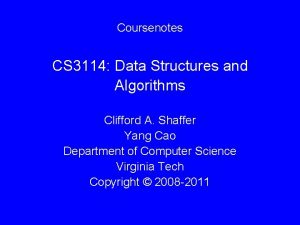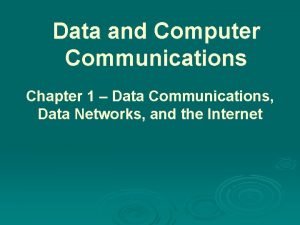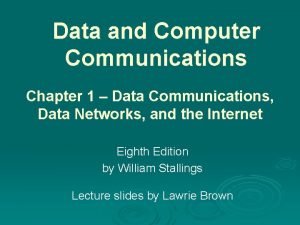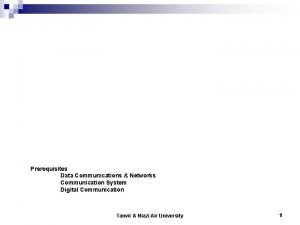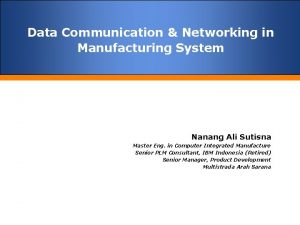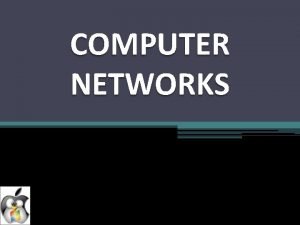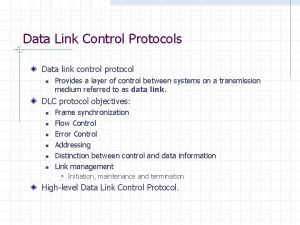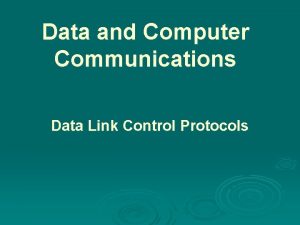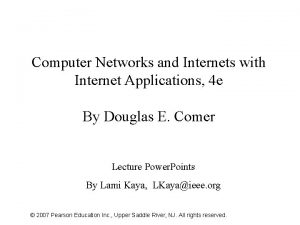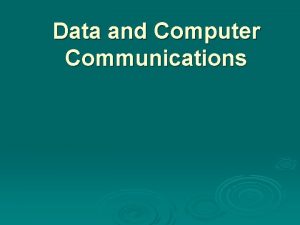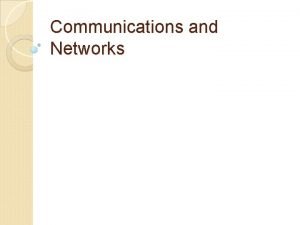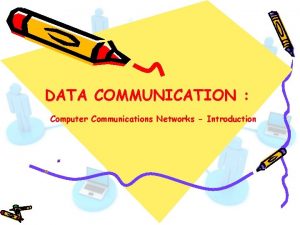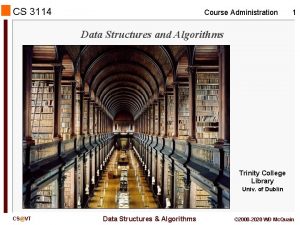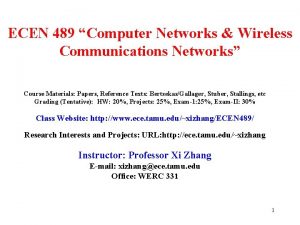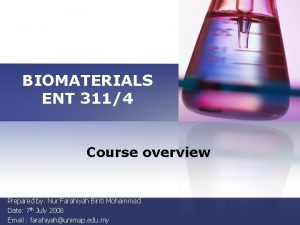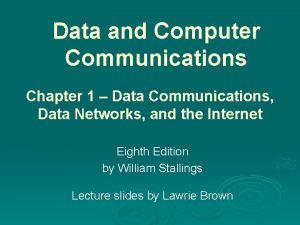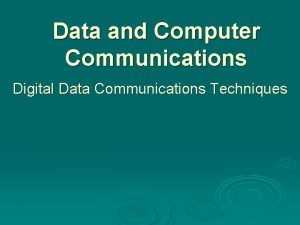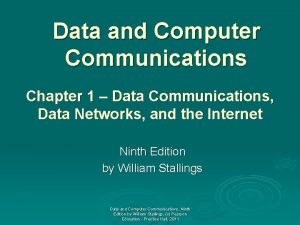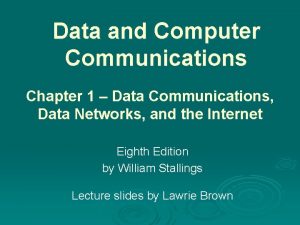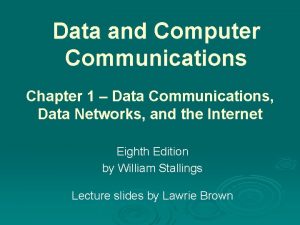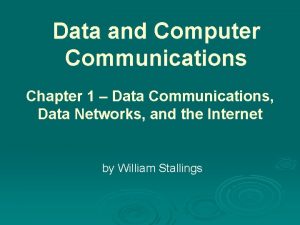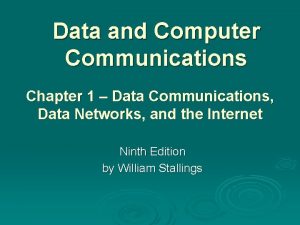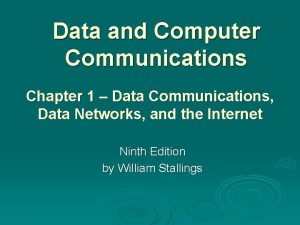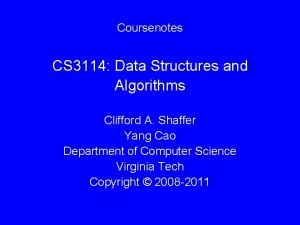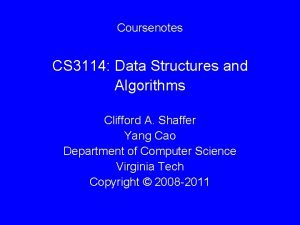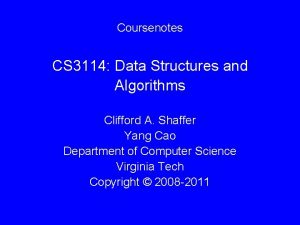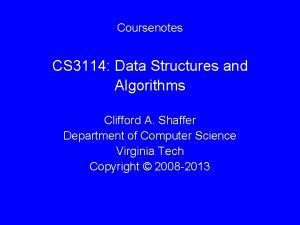Computer Networks and Data Communications Course Code 3114































- Slides: 31

Computer Networks and Data Communications Course Code: 3114 Instructor: Atuheire Izaara Ambrose Credit: 4. 0 When: Thursday 11: 00 – 12: 30 pm Venue: Post Graduate Room 1

• EXPECTATIONS?

My Expectations • Attend all lectures • Implement assigned projects • Do coursework and be involved in class discussions • Implement one final project

Prerequisites • Computer Skills / knowledge on Internet • Course site: https: //lms. must. ac. ug/ • You will be able to access all the Lecture presentations and electronic textbooks through the LMS. 3114 • Enrolment key is

Software's to use • Packet Tracer 6 or 7. 2

EVALUATION SYSTEM INCLASS: In class assignments 30% MID-TERM TEST: 50% All computed out of 40% FINAL PROJECTS: GROUP PROJECTS ATTENDANCE CRUCIAL TO ENHANCE PASSING!!!! 20% FINAL EXAM 100 % Computed out of 60%

SEMESTER PROJECT • ……. Suggestions? ? • You will be required to use the knowledge you acquire in this class to design a structure of Mbarara University campus network using packet tracer. • Presentations will be in November.

Course Content Tentative Course Content Lecture 1: Overview of the Course and Network Fundamentals: 2 Hour Lecture 2: OSI Model& TCP/IP Model : 2 Hour Lecture 3: Physical Media (Copper, Fiber Optic and Wireless) : 2 Hour Lab 1: Intro to Packet Tracer Lecture 4: UTP & Fiber Cabling: 2 Hour Lecture 5: LAN Technologies (Ethernet, Fast Ethernet, Gigabit Ethernet, Wireless LAN) : 2 Hour Lab 2: Demo and Practice of UTP Cabling: 2 Hour Lecture 6: LAN Technologies (contd. ) : 2 Hour

Course Content Lecture 7: WAN Technologies (Dialup, Leased Line, ISDN, ADSL, Cable Modem, VSAT) : 2 Hour Lab 3: Demo and Practice of Ethernet & Wireless LAN Setup : 2 Hour Lecture 8: WAN Technologies (contd. ) : 2 Hour Lecture 9: Internet Protocol (IP) and IP Addressing: 2 Hour Lab 4: Demo and Practice of Setting up Subnets and IP Address Assignment : 2 Hour Lecture 10: Routing, VLAN, TCP and UDP: 2 Hour Lecture 11: SNMP, Natting, Firewall and VPN: 2 Hour Lecture 12: Internet and Internet Applications (DNS, Email, Web. . ): 2 Hour

Course Content Tentative Course Content Lecture 13: Cisco Switch and Router Configuration : 2 Hour Lecture 14: Enterprise Networks and summative class: 2 Hour

Course Content Tentative Course Content Lecture 17: Mail Server, Proxy Server & Firewall Setup on Linux : 2 Hour Lab 8: Demo and Practice of Mail Server , Proxy Server and Firewall Setup : 2 Hour

Books References / Books Andrew S. Tanenbaum, Computer Network, Prentice-Hall Doughlas E. Comer, Computer Networks and Internet http: //www. cisco. com/public/support/tac/documentation. html

Introduction to Computer Networks INTRODUCTION TO COMPUTER NETWORKS

Introduction to Computer Networks Computer network connects two or more autonomous computers. The computers geographically anywhere. can be located

Introduction to Computer Networks LAN, MAN & WAN Network in small geographical Area (Room, Building or a Campus) is called LAN (Local Area Network) Network in a City is call MAN (Metropolitan Area Network) Network spread geographically (Country or across Globe) is called WAN (Wide Area Network)

Introduction to Computer Networks Applications of Networks Resource Sharing Hardware (computing resources, disks, printers) Software (application software) Information Sharing Easy accessibility from anywhere (files, databases) Search Capability (WWW) Communication Email Message broadcast Remote computing Distributed processing (GRID Computing)

Network Criteria • Performance • Depends on Network Elements • Measured in terms of Delay and Throughput • Reliability • Failure rate of network components • Measured in terms of availability/robustness • Security • Data protection against corruption/loss of data due to: • Errors • Malicious users 1. 17

Physical Structures � • Type of Connection • Point to Point - single transmitter and receiver • Multipoint - multiple recipients of single transmission • Physical Topology • Connection of devices • Type of transmission - unicast, mulitcast, broadcast 1. 18

Figure 1. 3 Types of connections: point-to-point and multipoint 1. 19

Introduction to Computer Networks Network Topology The network topology defines the way in which computers, printers, and other devices are connected. A network topology describes the layout of the wire and devices as well as the paths used by data transmissions.

Introduction to Computer Networks Bus Topology Commonly referred to as a linear bus, all the devices on a bus topology are connected by one single cable.

Introduction to Computer Networks Star & Tree Topology The star topology is the most commonly used architecture in Ethernet LANs. When installed, the star topology resembles spokes in a bicycle wheel. Larger networks use the extended star topology also called tree topology. When used with network devices that filter frames or packets, like bridges, switches, and routers, this topology significantly reduces the traffic on the wires by sending packets only to the wires of the destination host.

Introduction to Computer Networks Ring Topology A frame travels around the ring, stopping at each node. If a node wants to transmit data, it adds the data as well as the destination address to the frame. The frame then continues around the ring until it finds the destination node, which takes the data out of the frame. Single ring – All the devices on the network share a single cable Dual ring – The dual ring topology allows data to be sent in both directions.

Introduction to Computer Networks Mesh Topology The mesh topology connects all devices (nodes) to each other for redundancy and fault tolerance. It is used in WANs to interconnect LANs and for mission critical networks like those used by banks and financial institutions. Implementing the mesh topology is expensive and difficult.

Introduction to Computer Networks Network Components Physical Media Interconnecting Devices Computers Networking Software Applications

Introduction to Computer Networks Networking Media Networking media can be defined simply as the means by which signals (data) are sent from one computer to another (either by cable or wireless means).

Introduction to Computer Networks Networking Devices HUB, Switches, Wireless Access Modems etc. Routers, Points,

Introduction to Computer Networks Computers: Clients and Servers In a client/server network arrangement, network services are located in a dedicated computer whose only function is to respond to the requests of clients. The server contains the file, print, application, security, and other services in a central computer that is continuously available to respond to client requests.

Introduction to Computer Networks Networking Protocol: TCP/IP

Introduction to Computer Networks Applications E-mail Searchable Data (Web Sites) E-Commerce News Groups Internet Telephony (Vo. IP) Video Conferencing Chat Groups Instant Messengers Internet Radio

Assignment to be done Next week • Study the OSI and TCP models and their relevance in the Networking process. Make hand written summative notes on your findings. • To be handed in on 6/9/2018.
 Differences between virtual circuits and datagram networks
Differences between virtual circuits and datagram networks Basestore iptv
Basestore iptv Cs 3114
Cs 3114 Data and computer communications 10th edition
Data and computer communications 10th edition Data & computer communications
Data & computer communications Data and computer communications
Data and computer communications Simplified data communication model
Simplified data communication model Digital communications and networks
Digital communications and networks 10 subject name
10 subject name Communications networks manufacturing
Communications networks manufacturing Data link layer switching
Data link layer switching Utopian simplex protocol
Utopian simplex protocol Data link layer in hdlc in computer networks
Data link layer in hdlc in computer networks Digital data to digital signal encoding
Digital data to digital signal encoding Elementary data link protocols in computer networks
Elementary data link protocols in computer networks Data link control
Data link control Data link control protocols in computer networks
Data link control protocols in computer networks Busceral
Busceral Course title and course number
Course title and course number Diffserv vs intserv
Diffserv vs intserv Error detection in computer networks
Error detection in computer networks Bit and byte stuffing
Bit and byte stuffing What is byte stuffing in computer networks
What is byte stuffing in computer networks Reverse arp
Reverse arp Analog and digital signals in computer networking
Analog and digital signals in computer networking Web and http in computer networks
Web and http in computer networks Computer networks and internets with internet applications
Computer networks and internets with internet applications Hamming distance in computer network
Hamming distance in computer network Protocols and standards in computer networks
Protocols and standards in computer networks Error correction in computer networks
Error correction in computer networks Computer networks and internets
Computer networks and internets It means communication at a distance
It means communication at a distance


